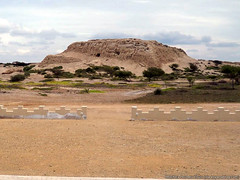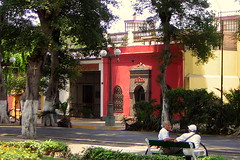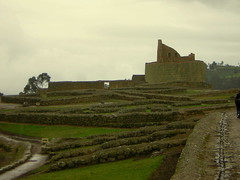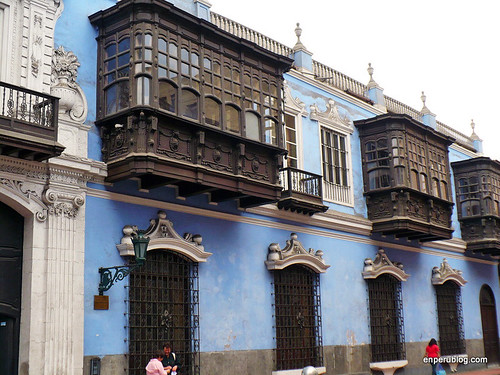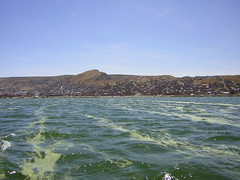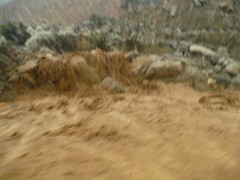US Expat Barbara Drake talks about the win by La Teta Asustada of best film at the Berlin film festival last week and about other notable works covering a dark period of contemporary Peruvian history.
Category: "Life"
Drought fears: 35% loss of harvest & blackouts in Arequipa [Featured]
Splaktar, a US citizen living in Arequipa, comments on recent news that the lack of rain in this mountainous area could cause a loss of 35% of the year’s harvest and blackouts due to lack of hydro power.
Apparently many areas, especially the south, in Peru are seeing are large reduction in rainfall this year. This could be caused by a cooler ocean as most of this rain comes directly from the Pacific and the Humboldt current.
They are predicting that this lack of rainfall could lead to the loss of 35% of this summer’s harvest (the primary harvest of the year).
Could the streets of Lima be on the verge of changing forever?
The year is 2010. It’s, let’s say, December, and the start of summer in the southern hemisphere and in the city of Lima.
Stepping out into the street, a family decides they will walk the 20 minutes to the Costa Verde, taking time to enjoy the city’s clean fresh air. Others live further away of course, so the streets are as full of traffic, including buses and taxis, as always. But apart from the gentle hum of the motors – many of which belong to hybrid cars – the streets are quiet. The combis weave in and out of the hybrids, in a rush to reach the next authorised bus stop to pick up and drop off passengers.
For the first time, such a future in Lima is entirely plausible.
Maids Still Banned from Swimming at Beaches? Sadly, Yes [Featured]
US Expat Barbara Drake sums up the discriminatory by-laws enforced by wealthy homeowners at the up-scale beach resort of Asia.
It’s something I wanted to write about two years ago when there was a lot about it in the newspapers and on various Peruvian blogs, but didn’t have the energy. Here Barbara explains that since that time, little has changed…
The last stop – Nostalgia Street
Public transport in Lima used to be orderly, clean, efficient and safe. Bus routes ran across the city in an organised way, drivers and ticket sellers were gentlemanly and vehicles were uniform and spacious. This all changed with the Presidency and quasi-dictatorship of Alberto Fujimori in the 1990s, something that the old-timers of the transport industry lament.
Driving in Lima, Peru
Driving in Peru, and particularly in Lima, is a challenge. Drivers ignore the rules of the road, have no consideration for others and die at a rate of 30 per 100,000 vehicles per year.
The British Embassy warns visitors:
Driving standards in Peru (particularly in Lima) are poor, with stop signs and traffic lights frequently ignored. Drivers overtake on either side, with little concern for pedestrians or oncoming traffic. Crashes resulting in death and injury take place almost every day.
While the US Embassy warns visitors:
Driving conditions in Peru are very different from those found in the United States and can be considerably more dangerous. Visitors are strongly encouraged to familiarize themselves with local law and driving customs before attempting to operate vehicles.
So, lets familiarize ourselves with the local regulations and customs. To do this, we will walk through some simple multiple choice questions like those Peruvians must answer to be awarded a driver’s licence. Answer them correctly and you too will be qualified to drive in Lima and Peru!
Part 3: A visit to the men’s prison in San Juan de Lurigancho [Featured]
Junior Moya is a Peruvian living in Lima who recently had the opportunity to visit the infamous men’s prison located in the run down district of San Juan de Lurigancho. In three parts, he tells us of his experience. (Thanks Junior!)
Part 2: A visit to the men’s prison in San Juan de Lurigancho [Featured]
Junior Moya is a Peruvian living in Lima who recently had the opportunity to visit the infamous men’s prison located in the run down district of San Juan de Lurigancho. In three parts, he tells us of his experience. (Thanks Junior!)
Part 1: A visit to the men’s prison in San Juan de Lurigancho [Featured]
Junior Moya is a Peruvian living in Lima who recently had the opportunity to visit the infamous men’s prison located in the run down district of San Juan de Lurigancho. In three parts, he tells us of his experience. (Thanks Junior!)
Grandes Civilizaciones: Antiguo Peru – Excellent Bargain
One of Peru’s national newspapers, El Comercio, have released this high quality hard-back book written by celebrated archaeologist Walter Alva and researcher Maria Longhena.
Sold at Peruvian prices, this book written in Spanish features full-page glossy colour images, can be had for a substantial discount on the US$50-US$60 it sells for world wide.
Panettone Madness [Featured]
US Expat Barbara Drake sums up the madness surrounding the sweet Italian treat known in Peru as panetón. By my conservative estimate, the average Peruvian eats 2.5 metric tonnes of panettone each Christmas. Well, that might not be entirely accurate, but it sure looks it to the casual observer. How this affects Peru’s miraculous weight-loss power, I’m not sure.
La Oroya: House of Lead: A story of Greed
International attention comes and goes, but La Oroya is in the spotlight once more as CNN begins its coverage of the town where 99% of the population is heavily lead-poisoned by up to three times the highest healthy limit, have strange rashes, stomach pains, are intellectually stunted, covered in layers of toxic dust of which 1,000 tonnes is omited per day, and where children are dying regularly. Living in this town means you are 2000 times more likely to die of cancer… that’s if you are even born. Should you not be miscarried, you are born pre-lead-poisoned and already risk not growing up at all.



